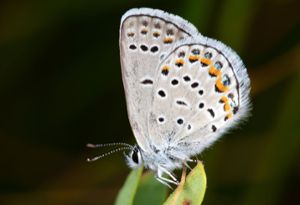Midwestern butterflies could be key to understanding the "Insect Apocalypse"
With the help of a $500,000 grant from the United States Geological Survey (USGS) Midwest Climate Adaptation Science Center and 30 years of data, Michigan State University quantitative ecologist Elise Zipkin and her multi-institution team will shed new light on the “Insect Apocalypse.”

Butterflies, like many insects, are ectotherms—organisms that cannot regulate their own body temperature. These insects require specific temperatures to grow and mature, so climate change could play a major role in their future distributions and population sizes.
Because more data exist for butterflies than many other insect species, studying them could be key to understanding the decline of insect populations worldwide. Although scientists cite many reasons for insect declines, the effects of climate change remain unknown and hard to quantify.
In a recent study, Zipkin, an associate professor in the Department of Integrative Biology in the College of Natural Science and director of MSU’s Ecology, Evolution, and Behavior Program, developed a modeling strategy to analyze climate effects on monarch butterflies and found a strong correlation between temperature and precipitation in spring and summer breeding ranges and the subsequent size of the overall population.
Motivated by these findings, her team—composed of researchers at MSU, Georgetown University, the USGS, and the U.S. Fish and Wildlife Service—is extending the models to other species.
“When we start digging deeper, we are going to look at tens, and eventually hundreds of butterfly species,” Zipkin said. “If we can understand factors affecting butterflies generally, we can get insight into what may be happening to other insect taxonomic groups.”

Thanks to volunteer efforts, butterfly data are abundant across the Midwest. Citizen scientists from state butterfly monitoring networks in Ohio, Illinois, Michigan, and Iowa have been tracking butterflies on the same paths every year for upwards of 20 years. School groups and other volunteers with the North American Butterfly Association have also been counting butterfly populations each summer.
“The Midwest has some of the most—if not the most—data available on butterflies in the world, so it is the optimal place to be doing this research,” Zipkin said.
To analyze the data, Zipkin’s lab will develop statistical models using two important techniques: data integration and community modeling. Data integration is the process of combining multiple sources of data into a unified analysis, and community modeling is a method of linking models of individual species to gain insight into rarer, more data deficient species. With these models, they can then forecast species populations in relation to projected climate change, providing valuable information to wildlife and habitat management.

“If you think of the Midwest of the past, you think of huge prairies and grasslands,” Zipkin said. “Many people are interested in restoring some of those areas to help bolster native plant and insect species. With the results of this study, we can help them figure out where to focus restoration efforts.”
Action-oriented science is an important part of USGS Climate Adaptation Science Centers. The goal of their grants is to produce results that make a difference in on-the-ground conservation efforts. In addition to shedding new light on the “Insect Apocalypse,” this research will provide valuable information for managing midwestern butterfly populations.
"The Midwest Climate Adaptation Science Center is pleased to support this study because it responds to the demand from fish and wildlife agencies to elucidate the role of climate change in insect declines," said Olivia LeDee, acting director of the U.S. Geological Survey Midwest Climate Adaptation Science Center. “The results will provide managers with the best available science to focus limited resources in areas where there is a high probability of long-term success.”
Banner image: A Poweshiek Skipperling butterfly sitting on a flower in Michigan. Conservation managers and zoos are working to save this endangered butterfly from extinction. Photo credit: Dave Pavlik